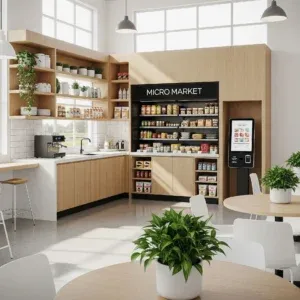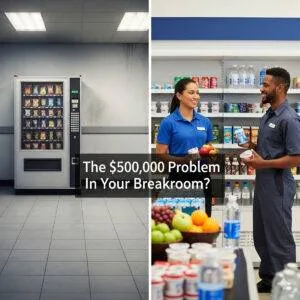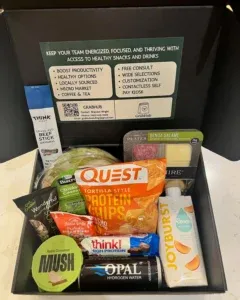Trends & Culture • Phoenix, AZ
The Rise of Unattended Retail: What Phoenix Employers Should Know in 2025
Unattended retail has moved from airports and campuses to everyday workplaces. Here’s the executive briefing on what’s driving the trend, the 3‑year outlook, and how Facilities, HR, and IT should plan for tech‑enabled breakrooms in Phoenix.
As office amenities modernize, tech‑enabled amenities (smart kiosks, AI‑assisted inventory, and smart coolers) are becoming standard. This guide translates market signals into practical next steps for your site plans and budgets.
Why It’s Not a Fad: The Demand Stack
Multiple forces—not hype—are pushing unattended retail mainstream:
- Frictionless expectations: Consumers now default to tap‑to‑pay and self‑checkout. Unattended formats meet that expectation inside the workplace.
- Variety + freshness: Micro markets enable fresh meals, hydration, and high‑protein options—not just shelf‑stable snacks.
- Data‑driven ops: Smart kiosks feed inventory platforms that predict restocks and reduce waste.
- Safety & compliance: Smart coolers health‑lock if temps drift, supporting FDA Food Code style controls.
Analysts track sustained adoption and card‑present volume growth in unattended categories; market snapshots point to continued double‑digit expansion as AI and smart‑cooler tech mature.Carat/FiservTBRC
2025–2028 Outlook: What Changes (and What Doesn’t)
Expect steady growth in deployments and sophistication, not a wholesale reinvention:
- Payments: Wider mobile wallet usage and account‑based pricing (subsidies/stipends) at the kiosk.
- Automation: More AI‑assisted planograms and demand forecasting to right‑size fresh food without waste.
- Compliance & telemetry: Temperature logging, remote health locks, and tamper‑evident packaging as table stakes.
- Experience: Simple, reliable self‑checkout and better on‑shelf curation—less time off‑site, better afternoons.
| Trend | What It Means | Examples | Action for Employers |
|---|---|---|---|
| Frictionless Checkout | Tap‑to‑pay + wallet‑first behavior across age groups. | Apple/Google Pay, account‑based discounts at kiosk. | Plan for cashless‑only kiosk locations and clear signage. |
| AI‑Assisted Inventory | Higher in‑stock rates with less spoilage. | Predictive restocking, seasonal menus, heat‑driven hydration sets. | Ask vendors for KPIs: in‑stock %, waste %, and freshness rotation. |
Planning Horizon: A Practical 12–18 Month Path
Small pilot → measure → scale by building/shift. Keep Facilities, HR, and IT aligned.
-
Step 1
Assess & Fit
Map headcount by shift, space, power, and network. Validate Phoenix/Maricopa compliance basics (mop sink, finishes, ANSI equipment).
-
Step 2
Pilot & Measure
Launch one market with clear KPIs (usage, in‑stock %, waste %, satisfaction). Run a hydration/wellness promo in summer.
-
Step 3
Scale & Standardize
Roll to additional buildings. Standardize planograms, security camera angles, and stipend/subsidy rules.
-
Step 4
Optimize Quarterly
Quarterly business reviews with HR/Facilities. Tune assortment, pricing, and wellness campaigns to goals.
The Stack Behind the Trend
Unattended retail succeeds when simple, reliable tech meets good merchandising.
Smart Kiosks
PCI‑compliant, wallet‑friendly checkout; supports employer subsidies and stipends when needed.
AI Inventory
Predictive restocking lifts in‑stock rates and trims waste—critical for fresh assortments.
Smart Coolers
Continuous temperature telemetry + auto health locks to protect food safety.
Signals Pointing Up
Adoption indicators that matter for workplace planning.
Context: analyst trend briefs and payment market commentary. See Carat/Fiserv and TBRC.
Executive FAQs
No. Payment and consumer trends favor frictionless, cashless experiences. Workplace formats like micro markets match those expectations while enabling fresh, curated assortments.
Analysts project continued double‑digit growth with broader AI use in inventory and wider deployment of smart‑cooler safety features.
Plan space, power, network, and camera coverage for a micro market footprint, and align policy levers like subsidies/stipends with wellness and shift‑support goals. Link with IT for cellular/Ethernet choices.






